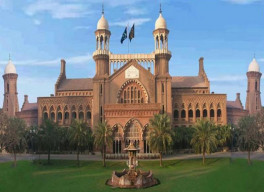
Work on the original LHC building with the central wing comprising two courtrooms, a committee room and a surrounding quadrangular building started in 1882 and completed seven years later. From 1866 to 1887, the judges had been sitting at the building, where the Services and General Administration Department at the Civil Secretariat is housed now.
About 49 years ago, the government of Ayub Khan first marred the view of the British-era building by incorporating a new block. The change continues today. In February, a huge three-story structure was erected by the Lahore High Court Bar Association (LHCBA).
In June 2014, Justice Anwarul Haq while speaking at the augural ceremony of building’s renovated eastern wing had said the eastern and western two-storey wings of the building were set up in 1923 in the style of the frontal features of the central wing.
The LHC premises comprise about 550,000 square feet, containing within the building of the LHCBA, which is known as Kiani Hall these days, with additional small halls in its north and south.
The remaining area was open till 1967 when General Ayub Khan, the first martial law administrator, constructed a three-storey building having eight courtrooms and a library. He inaugurated the building on February 20, 1967.
Another blow to the original building came in 1974 with the construction of another two-storey wing having four courtrooms by the then chief justice Sardar Muhammad Iqbal.
Both these wings marred the view of the LHC’s original building from the south. In 1976, another building, which is known as Allama Iqbal Lounge of the LHCBA, was constructed within the LHC premises that obstructed the view from the west.
Then in 1999, a three-storey wing was constructed with 12 courtrooms near the LHC boundary on Turner Road. The building was inaugurated by then chief Justice Rashid Aziz.
The largest losses to the structure came during the reign of another military dictator Pervez Musharraf. Then chief justice Iftikhar Hussain Chaudhry, who supported the first Provisional Constitutional Order of Musharraf, got the western wing of the original building demolished overnight in 2004, inviting the ire of civil society and lawyers.
Incumbent LHC Chief Justice Syed Mansoor Ali Shah was an active participant and supported taking the case to the Supreme Court, which ordered the LHC to reconstruct the building as it was before its demolition. The construction was completed with a second storey building having eight courtrooms and was inaugurated on June 19, 2008.
Former chief justice Umar Ata Bandial also contributed to changing the LHC building by constructing a double-storey mosque, which was inaugurated on July 19, 2012.
Illegal additions?
The LHC building was listed as a protected building under a notification dated March 21, 1985, and no addition or deletion can be made into this building. These additions into the original structure are in violation of Section 5 of the Punjab Special Premises (Preservation) Ordinance 1985.
Since his elevation as the top judge, Chief Justice Mansoor has taken special interest in restoring the building to its original shape. So far the eastern wing, committee room and the guestroom have been renovated.
Kamil Khan Mumtaz, a renowned architect who assisted in renovating the LHC building’s eastern wing to its original shape, lamented that enough had been done with the building of the LHC and no more structures should be added in the premises. “If more courtrooms are needed, they should be built at some other place or even other cities.”
Published in The Express Tribune, November 21st, 2016.


























1714024018-0/ModiLara-(1)1714024018-0-270x192.webp)










COMMENTS
Comments are moderated and generally will be posted if they are on-topic and not abusive.
For more information, please see our Comments FAQ